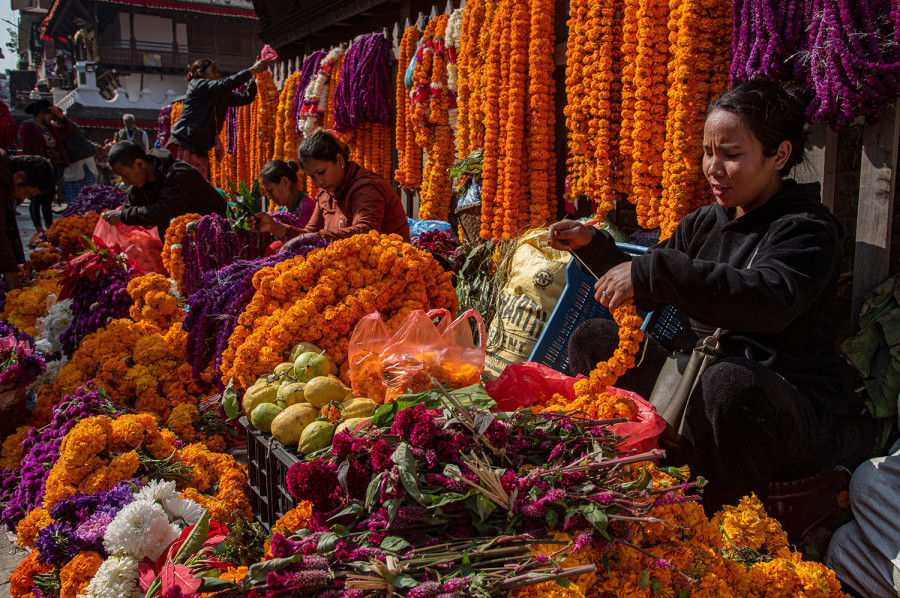
SATV Kathmandu Oct 13: The festival of flowers and lights, Tihar, is a week away, but traders said that, like Dashain, they are not expecting festive bonanza sales due to uncertainty and fear following the Generation Z protests in early September.
Flower and festive light traders said that as the corporate houses in Kathmandu Valley were severely damaged during the protest last month, the demand for flowers and lights is expected to decline sharply. The demand for flowers and lights in corporate houses used to be high during Tihar.
Colourful blossoms are a major feature of the festival. People festoon the doors and windows of their houses with strings of flowers, and sisters place garlands around the necks of their brothers as part of rituals.
The flower producers said prices have remained unchanged this year compared to last year due to the low demand.
A metre of marigold garland will cost around Rs100, nearly the same as last year, said Rajesh Bhakta Shrestha, president of the Floriculture Association Nepal. “The price is hovering around the same as last year’s Tihar as the demand has declined.”
A one-metre-long garland contains around 40 flowers.
According to the association, Makhamali (globe amaranth) will cost Rs60–65 per garland.
Shrestha said that the recent rainfall has not damaged production, so domestic production can fulfil 90 percent of the demand.
Due to a decline in sales, flower producers’ sales expectations have also lowered. “Last year, flower producers made transactions of Rs350 million, and we expect the figure to hover around the same this year.”
Festive light traders are also not excited, despite Tihar being just around the corner.
People decorate their homes with lights, believing that the goddess of prosperity, Laxmi, visits their house during the new moon night. Traditionally, people used to light oil lamps and candles, but after the end of the long loadshedding problem, more and more attractive Chinese lights started arriving in the market at reasonable prices.
People began opting for festive lights, which are also considered safer compared to traditional oil lamps and candles that can cause fires.
“The uncertainty and fear in the absence of law and order have reduced the confidence of traders too, and customers also do not seem to be celebrating openly as criminal activities have been increasing,” said Resham Prasad Devkota, president of the Federation of Electrical Entrepreneurs Nepal.
The demand for lights has also declined as the construction of new homes has reduced, and people who have already bought LED lights do not need to buy them frequently since they last for 3–4 years, festive light traders said.
The federation estimated festive light sales worth around Rs250 million in the last fiscal year and is expecting the same this year.
According to the federation, almost 80 percent of the festive lights ordered from China have arrived and are being distributed to wholesalers. Most of the lights came through the Tatopani border, with a few shipments arriving from Kolkata port via ship.
For nearly two months, hundreds of containers loaded with festival-targeted goods have been stuck in Tibet after landslides and floods severed Nepal’s vital trade routes with China.
At the Rasuwagadhi border crossing, a flash flood from China in July swept away the Miteri Bridge and damaged customs facilities. Repeated landslides along the Araniko Highway have also blocked the alternative Tatopani route.
China has become a critical supplier for Nepal’s festivals, especially garments and decorative items.
Devkota said that the prices of lights have not gone up this year.
Festive light traders said that LED lights with varying lengths and light effects, crystal lights, and the usual rope lights were the most popular festive items for Tihar.
Meanwhile, the price of dried fruits—one of the essential items of Tihar—has increased. Women give their brothers packets of nutritious nuts, seeds, and other items as gifts during the ceremonies, and sales soar this time of the year.
Different traders that the Post talked with said that the price of dried fruits has increased this year due to the strong US dollar. Market opportunists also tend to manipulate and raise prices during festivals when demand peaks.
Basanta Shrestha, treasurer of the Nepal Retailers Association, said that the price of some dry fruits has increased by Rs20 to Rs150 per kg this year, while others have remained stable. The price of dried coconut has increased by Rs150 to Rs800 per kg in retail. The price of cashew nuts has remained unchanged at Rs1,780 per kg. Dates are priced at Rs550, raisins at Rs600 per kg, and walnuts at Rs525 per kg.














